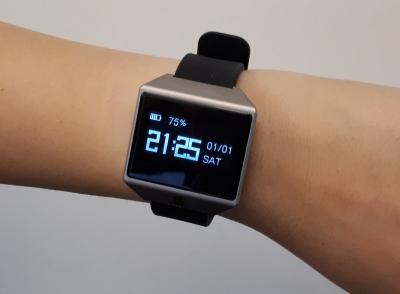Graphene CVD sheets - updates and market status - Page 7
Graphenea launches new foundry service
Graphenea recently launched a graphene foundry service GFAB. The company will manufacture custom circuit designs on graphene wafers up to 6. The service is aimed at enabling fast device prototyping and accelerating development of new applications, lowering entry barriers to graphene-based solutions.

Graphenea states that in view of the market demands, the offer now includes small batch sizes (1-3 wafers). Lithography masks can be manufactured by Graphenea or provided by the customer. GFAB includes graphene growth, transfer on 4 and 6 wafers, metal contact deposition and lift-off, and graphene lithography with etching.
Researchers use graphene to detect mid-infrared light at room temperature and convert it into electricity
Researchers from ICFO and Yale have used graphene to efficiently detect mid-infrared light at room temperature and convert it into electricity. Detecting infrared light is of major importance for current applications in spectroscopy, materials processing, chemical, bio-molecular and environmental sensing, security and industry since the mid-infrared spectral region is the range where characteristic vibrational transitions and rotational excitations of many important molecules occur.
 Schematic of the proposed device, composed of graphene-disk plasmonic resonators connected by quasi-1D graphene nanoribbons
Schematic of the proposed device, composed of graphene-disk plasmonic resonators connected by quasi-1D graphene nanoribbons
These vibrational and rotational excitations of many molecules, including hazardous and biological molecules, have frequencies that are found in the mid-infrared, which can be monitored by observing the absorption of light in this specific spectral range. However, currently available mid-infrared detectors are very inefficient, except those that can operate at cryogenic temperatures, because they incorporate superconducting elements. Thus, this low temperature limitation is a major drawback in having detectors integrated in devices for consumer products.
Graphene Flagship partners design graphene-based phase modulators for faster mobile technology
Graphene Flagship Partners at the National Inter-University Consortium for Telecommunications (CNIT) in Italy, IMEC in Belgium and University of Cambridge in UK have designed and tested a graphene-based phase modulator that reportedly outperforms existing silicon-based ones.
Modern optical data and telecommunications employ phase modulators to increase the amount of data relayed and data rate efficiency, i.e. the speed at which information is relayed. Phase modulators traditionally work by grouping several bits of information into fewer symbols, or packets, reducing the overall size, or spectral width. The smaller the spectral width, the higher the data rate efficiency. However, this efficiency is reaching a maximum with silicon based devices, and so a novel solution is needed to bridge the gap between the increase in demand for data and the efficiency in transmitting it.
BOE Display is looking into graphene-based touch panels for next-gen flexible displays
China-based display maker BOE Group announced that it is looking into adopting graphene for next-generation touch screens.

The company says that graphene has several advantages over current technologies, though production capacity remains insufficient at this stage.
MIT team demonstrates a novel method to mass-produce graphene in long rolls
Researchers at MIT have developed a method that might enable the production of long rolls of high-quality graphene. The continuous manufacturing process can reportedly produce five centimeters of high-quality graphene per minute. The longest run was nearly four hours, and it generated around 10 meters of continuous graphene.

MIT is referring to the development as the first demonstration of an industrial, scalable method for manufacturing high-quality graphene that is tailored for use in membranes that filter a variety of molecules. These membranes could be used in biological separation or desalination, for example. The researchers drew from the common industrial roll-to-roll approach blended with chemical vapor deposition, a common graphene-fabrication technique.
The graphene-enhanced GF1 health smart watch is now shipping in the US
In January 2018 we posted a short hands-on review of Wuxi Graphene Film's GF1 Graphene Watch, a smart health watch, with CVD graphene film acting as the conductive element for the touch screen.

The GF1 has been shipping in China since late 2017, and the watch has finally reached the US via Amazon.com, where it can be bought for $55.
XFNano’s CEO discusses the company’s business and technology
Mr. Xu Jiang, president and general manager of China’s XFNano, was kind enough to answer a few questions we had for him regarding XFNano’s graphene materials, technology and business. Mr. Jiang founded XFNano in 2009, and he holds a master’s degree from Nanjing University of Posts and Telecommunications.

Q: Hello Mr. Jiang, thank you for your time. Can you update us on your graphene production process and facilities?
In 2016, XFNANO put its new production line into operation, which yields an annual production capacity of 50 tons of high-quality graphene powder and 1,000 tons of graphene dispersion. We believe this can meet our customers’ demands for large quantities.
High-speed and on-silicon-chip graphene blackbody emitters
A research team from Japan has developed an integrated, high-speed and on-chip blackbody emitter based on graphene. The team reports that the device operated in NIR region including telecommunication wavelengths. A fast response time of ~ 100 ps, which is ~ 105 higher than the previous graphene emitters, has been experimentally demonstrated for single and few-layer graphene, the emission responses can be controlled by the graphene contact with the substrate depending on the number of graphene layers.
![]()
The team stated that graphene light emitters are greatly advantageous over conventional compound semiconductor emitters because they can be integrated on silicon chips due to simple fabrication processes of graphene emitters and direct coupling with silicon waveguide through an evanescent field. Because graphene can realize high-speed, small footprint and on-Si-chip light emitters, which are still challenges for compound semiconductors, the graphene-based light emitters can open new routes to highly integrated optoelectronics and silicon photonics.
EU project to develop graphene-based products for protection of artwork
An interesting project under the H2020 initiative is GRAPHENART - focused on examining graphene as an anti-fading agent for the protection of artworks. The project, funded at about â¬150,000, started at October 2017 and will go on until March 2019.
The reasoning behind the project is that fading, yellowing and discoloration are common degradation effects that result from exposure to UV and visible light and oxidizing agents, resulting in the irreversible alteration of the appearance of contemporary artworks. The GRAPHENART project aims to develop innovative, multi-functional graphene-based products (graphene ‘veils’ and inclusions) that provide UV shielding, de-acidification, oxygen and humidity barriers for the protection of old and modern paintings and artworks.
Graphenea launches a Chinese website to target the growing Chinese graphene market
Spain based graphene producer Graphenea has launched a new Chinese edition of its web site to specifically target the growing Chinese graphene market. China is becoming a leading adopter of graphene technologies, and Graphenea aims to supply its high-end materials for corporations in China.

Graphenea produces CVD graphene sheets, graphene oxide and reduced graphene oxide materials, which are on sale now in China via its online store.
Pagination
- Previous page
- Page 7
- Next page